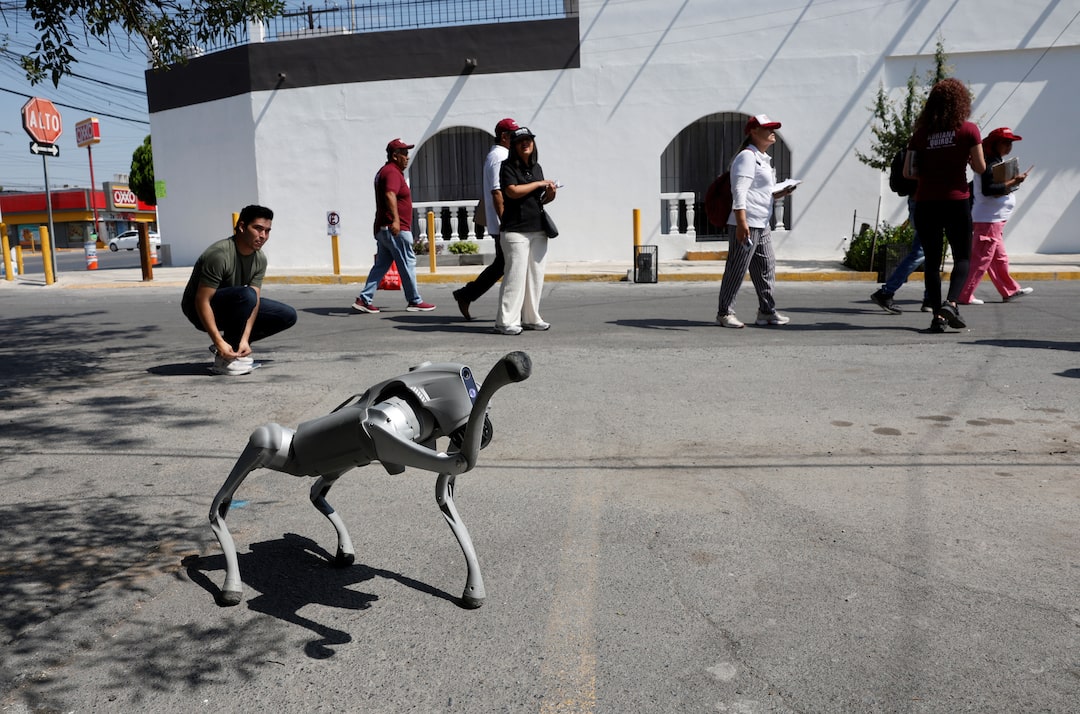In the lively streets of Monterrey, Mexico, an unusual visitor is turning heads and warming hearts an AI robot dog for animal welfare named Waldog. He doesn’t just walk or run he talks, plays, and delivers an important message animals deserve compassion, protection, and love.
With a beagle like size, shiny metallic body, and a friendly digital voice, Waldog roams the neighborhoods speaking to children and adults about animal rights. On August 8, in the low income area of Santa Catarina, he introduced himself to a crowd.
Hi, I’m Waldog, and I’m here to give a voice to those who don’t have one the animals who live on the streets.
How Technology Meets Compassion
Waldog is more than just a novelty. He’s a sophisticated combination of robotics and artificial intelligence designed to inspire kindness toward animals. Equipped with motion sensors, expressive head movements, and AI driven speech, he can respond naturally to people.
Dr. Ricardo Sánchez, a robotics expert from the Universidad Autónoma de Nuevo León, explains. The human brain is wired to form emotional bonds with creatures that move and respond like living beings. An AI robot dog for animal welfare can deliver impactful messages without the risks or stress a real animal might face.
By blending the charm of a pet with cutting edge AI, Waldog bridges technology and empathy in a way that traditional outreach methods rarely achieve.
Why Monterrey Needs This Kind of Innovation
Mexico faces a serious animal welfare challenge. According to the Mexican Association for the Protection of Animals, nearly 70% of the country’s dogs live on the streets, exposed to hunger, disease, and abuse. Public awareness campaigns often fail to connect with communities, especially in low income areas where resources are limited.
Waldog changes that. His friendly presence draws attention, and his conversations spark genuine reflection. Instead of lectures or posters, people encounter a playful companion who reminds them of their responsibilities toward animals.
In Santa Catarina, Waldog’s visit made an immediate impact. Ten year old Mariana, who once avoided stray dogs, said afterward. Waldog taught me that animals can feel pain and need food, water, and love.
Now, if I see a dog without food, I’ll try to help or ask someone who can. Her mother admitted that animal welfare was never a dinner table conversation before. Waldog had changed that within minutes.
Local teachers even invited Waldog to a school event, where he spoke to students about kindness, respect, and the importance of reporting animal abuse. The children’s enthusiasm proved that an AI robot dog for animal welfare can reach audiences in ways human campaigners sometimes can’t.
Expert Opinions on Social Robotics
Animal behaviorist Laura Jiménez points out that robots like Waldog offer unique advantages. A robot can go into environments where a real dog might be unsafe, and it can deliver consistent messages without fear, exhaustion, or harm. It’s an innovative way to promote empathy.
Psychologist Ernesto Velázquez adds that humans are surprisingly receptive to such machines. Even knowing it’s mechanical, people engage emotionally because the cues movements, voice tone, responsiveness mimic life. This emotional engagement is precisely what drives behavior change.
As a journalist, I approached Waldog expecting a tech gimmick. Instead, I saw teenagers who initially mocked him end up discussing animal shelters. I saw an elderly woman pat his metallic head and say she wished she had learned these lessons as a child.
The AI robot dog for animal welfare wasn’t just a spectacle he was a conversation starter, breaking barriers in ways leaflets and speeches rarely manage.
Beyond Animal Kindness: Inspiring Curiosity About AI
Waldog’s mission doesn’t stop at animal welfare. His presence also sparks curiosity about robotics, AI, and engineering. In schools, he not only teaches kindness but also introduces children to STEM concepts. This dual role promoting empathy and technological literacy makes him a unique educational tool.
Students often ask questions like, How does he move? or Can he learn new things? Teachers use these moments to explain AI, coding, and ethics in technology. In doing so, Waldog inspires the next generation of innovators while nurturing compassionate values.
Long Term Goals for Waldog
The creators plan to expand Waldog’s outreach to other Mexican cities and eventually across Latin America. They are developing a mobile app where children can interact with a virtual version of Waldog, extending his message beyond physical visits.
They also hope to collaborate with animal shelters, using Waldog as a bridge to encourage adoptions and donations. People are drawn to something they haven’t seen before. Waldog’s lifelike behavior encourages empathy.
He delivers facts in a friendly, memorable way. Unlike live animals, he can work in any environment without risk. Combining these factors makes the AI robot dog for animal welfare an effective ambassador for change.
A Mechanical Friend with a Real Heart
Waldog proves that technology can serve humanity in deeply meaningful ways. While he may be built from metal and circuits, his mission is purely human to promote compassion, understanding, and kindness toward animals.
In Monterrey’s streets, he’s not just a walking machine; he’s a spark for change, inspiring children, engaging adults, and proving that even in a world driven by technology, empathy is still our most powerful tool.

